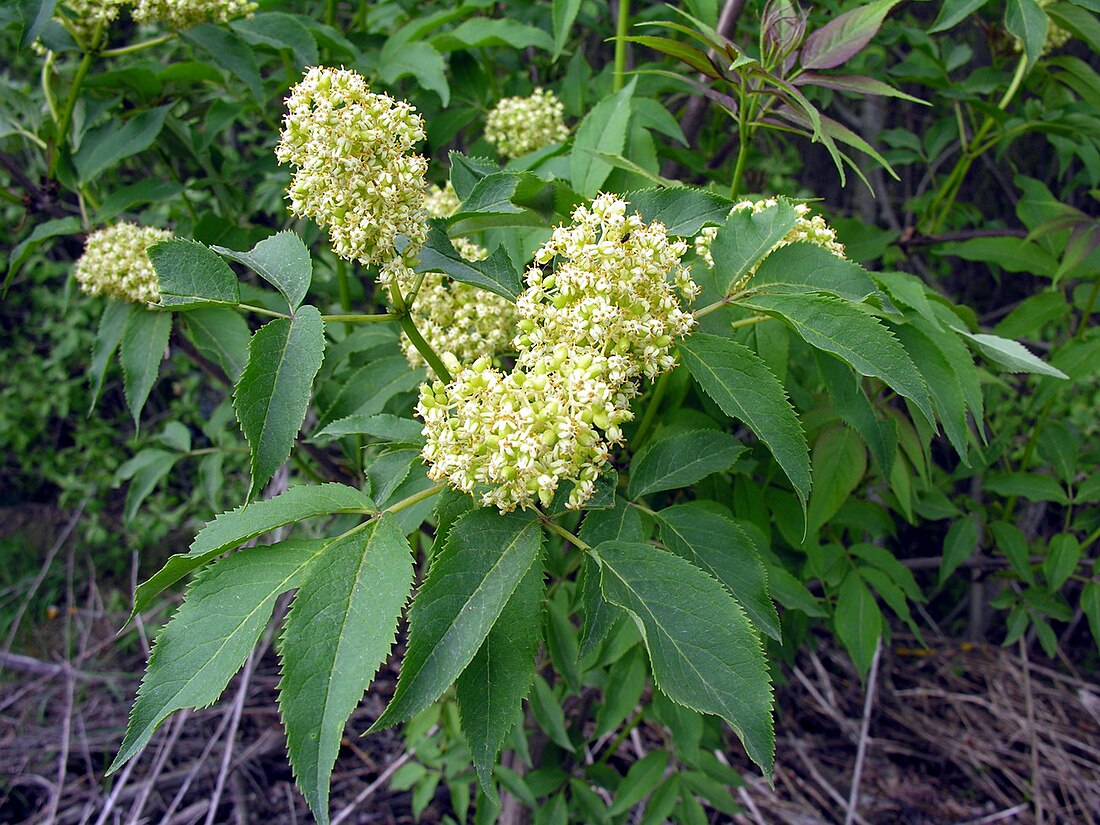Sambucus racemosa
Species of plant From Wikipedia, the free encyclopedia
Sambucus racemosa is a species of elder known by the common names red-berried elder[2][3] and red elderberry.[4] It is native across much of the Northern Hemisphere.[5]
| Sambucus racemosa | |
|---|---|
 | |
| Sambucus racemosa subsp. racemosa flowers, Lithuania | |
 | |
| Sambucus racemosa subsp. racemosa fruit, France | |
| Scientific classification | |
| Kingdom: | Plantae |
| Clade: | Tracheophytes |
| Clade: | Angiosperms |
| Clade: | Eudicots |
| Clade: | Asterids |
| Order: | Dipsacales |
| Family: | Adoxaceae |
| Genus: | Sambucus |
| Species: | S. racemosa |
| Binomial name | |
| Sambucus racemosa | |
| Subspecies[1] | |
| |
Description
Sambucus racemosa is medium-sized shrub growing 2–4 m (7–13 ft) (rarely 6 m (20 ft)) tall. The stems are soft, with a broad pith.
Each individual leaf is composed of 5 to 7 leaflike leaflets, each of which is up to 4–8 cm (1+1⁄2–3+1⁄4 in) (rarely to 16 cm (6+1⁄4 in)) long, lance-shaped to narrowly oval, and irregularly serrated along the edges. The leaflets have a strong disagreeable scent when crushed.[6][7]
The inflorescence is a vaguely cone-shaped panicle 3–6 cm (1+1⁄4–2+1⁄4 in) diameter, consisting of several cymes of flowers and produced on the ends of stem branches. The flower buds are pink when closed, and the open flowers are white, cream, or yellowish. Each flower has small, recurved petals and a star-shaped axis of five white stamens tipped in yellow anthers. The flowers are fragrant and visited by flies (particularly hoverflies), hummingbirds and butterflies.[6][8]
The fruit is a bright red drupe (to purple-black in var. melanocarpa) containing 3 to 5 seeds. It is eaten by birds, which disperse the seeds in their droppings.[9]
Varieties and subspecies
- Sambucus racemosa var. melanocarpa — Rocky Mountain elder, native to the Western United States and Western Canada, including the Rocky Mountains and Sierra Nevada.[10][11][12]
- Sambucus racemosa var. microbotrys (Rydb.) Kearney & Peebles – Southwestern United States[13]
- Sambucus racemosa subsp. pubens — American red elder, native to North America
- Sambucus racemosa subsp. racemosa — European red-berried elder.[14]
Other subspecies formerly included in S. racemosa include S. racemosa subsp. kamtschatica (now Sambucus kamtschatica), S. racemosa subsp. sibirica (now Sambucus sibirica), and S. racemosa subsp. sieboldiana (now Sambucus sieboldiana).[5]
Distribution and habitat
It is native to Europe, northern temperate Asia, and North America across Canada and the United States.[1] It grows in riparian environments, woodlands, and other habitats, generally in moist areas.[8]
Toxicity
The stems, roots and foliage are poisonous, and the berries can be toxic or cause nausea if eaten raw.[8]
Uses
It has been used as a traditional medicine by Native Americans, including the Bella Coola, Carrier, Gitksan, Hesquiaht, Menominee, Northern Paiute, Ojibwa, Paiute, Potawatomi, Tlingit, and Haida peoples.[8][15] The uses included as an emetic, antidiarrheal, cold and cough remedy, dermatological and gynecological aid.[15]
Food
The fruit is reportedly safe to eat[16] when cooked, but are potentially poisonous when raw. They were cooked in a variety of recipes by indigenous peoples, including by the Apache, Bella Coola, Gitxsan, Gosiute, Makah, Ojibwa, Quileute, Skokomish, Yurok peoples.[8]
Cultivation
Sambucus racemosa is cultivated as an ornamental plant, for use as a shrub or small tree in traditional and wildlife gardens, and natural landscape design projects.[8] The yellow-foliaged cultivars 'Plumosa Aurea' and 'Sutherland Gold' are widely grown in Britain.[3]
Cultivars
Cultivars in the nursery trade include:
- Sambucus racemosa 'SMNSRD4' Lemony Lace® — golden green foliage, with red new growth[17]
- Sambucus racemosa 'Sutherland Gold' — green foliage, with bronze new growth:[18] it has received the Royal Horticultural Society's Award of Garden Merit.[19][20]
Images
- Fruit of subsp. pubens, (Mount Baker-Snoqualmie National Forest)
- Inflorescence and foliage of subsp. pubens
- Young leaves and flowerbuds of subsp. racemosa
- Clusters of berries of subsp. racemosa
- Fruit of var. melanocarpa
References
External links
Wikiwand - on
Seamless Wikipedia browsing. On steroids.





